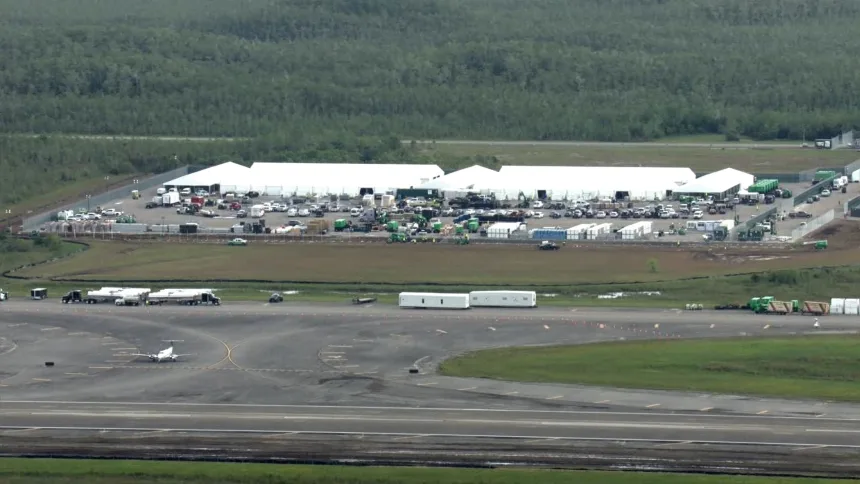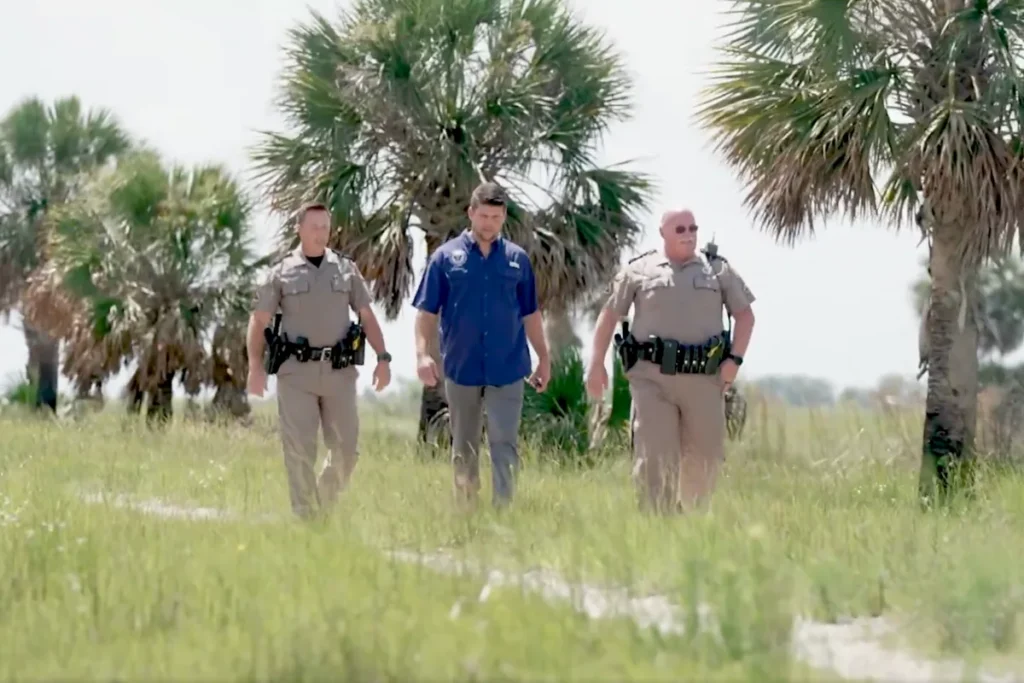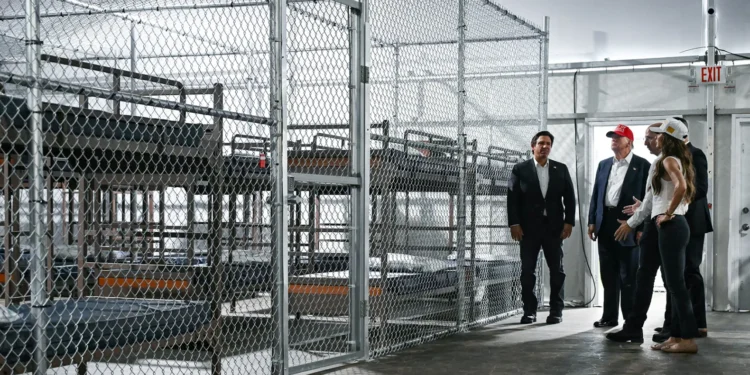The concept of “Alligator Alcatraz” has sparked intense debate across the United States. This nickname refers to a controversial immigration detention center planned for the Everglades in Florida. Backed by Governor Ron DeSantis, this ambitious project is set to become a significant immigration hub.
Located in the vast and ecologically sensitive Everglades, the detention center is expected to be operational by July 2025. The project has garnered attention not only for its massive scale but also due to concerns regarding its environmental impact and the politics surrounding its development.

The “Everglades detention facility” is more than just a controversial project; it represents a complex interplay of immigration policy, environmental concerns, and political will. As the project moves forward, understanding its implications is crucial.
Key Takeaways
- The detention center nicknamed “Alligator Alcatraz” is set to open in July 2025.
- It is located in the Everglades, Florida, sparking environmental concerns.
- The project is backed by Governor Ron DeSantis and has significant political implications.
- The facility is expected to be a major immigration detention hub.
- Environmental lawsuits and concerns surround the project’s development.





The Birth of Florida’s Most Ambitious Immigration Detention Center
The Everglades, known for its diverse wildlife, is now the chosen location for a large-scale immigration detention center. This project has sparked intense debate and controversy, with proponents arguing for its necessity in managing immigration and opponents highlighting environmental and humanitarian concerns.
Origin of the “Alligator Alcatraz” Nickname
The detention center has been nicknamed “Alligator Alcatraz” due to its location in the Everglades, an area teeming with alligators and other wildlife. This nickname underscores the challenging environment and the perceived harshness of the detention facility.
July 2025: The Planned Opening Date
The facility is slated to open in July 2025, marking a significant milestone in the project’s development. This timeline has raised concerns among environmentalists and local communities, who are worried about the potential impact on the ecosystem and the detainees.
As the opening date approaches, the debate surrounding “Alligator Alcatraz” is likely to intensify. The project’s proponents, including Governor Ron DeSantis, view it as a crucial component of Florida’s immigration policy. In contrast, opponents are mobilizing against the facility, citing environmental, legal, and humanitarian concerns.
Inside Alligator Alcatraz: Florida’s Everglades Detention Facility
Deep within the Big Cypress National Preserve in Ochopee, FL, lies the Alligator Alcatraz detention center, a facility designed to house thousands of detainees. This location, known for its natural beauty and diverse wildlife, has become the focal point of a controversial immigration detention project.
Location: Big Cypress National Preserve in Ochopee, FL
The Big Cypress National Preserve, a unique and ecologically sensitive area, has been chosen as the site for the Alligator Alcatraz detention center. This location is significant not only for its natural beauty but also for its proximity to the Everglades, an area of considerable environmental concern. The preserve is home to a wide range of flora and fauna, some of which are endangered.

Capacity and Infrastructure: Housing 5,000 Detainees
The Alligator Alcatraz detention center is planned to have the capacity to house up to 5,000 detainees, making it one of the larger immigration detention facilities in the United States. The infrastructure is being designed to accommodate this large number while attempting to minimize the facility’s environmental footprint. However, concerns remain about the potential impact on the local ecosystem and the challenges of managing such a large detention population in a remote area.
The infrastructure plans include not just the detention facilities but also support services and amenities necessary for the operation of such a large center. This includes administrative buildings, medical facilities, and recreational areas for detainees.
Fast-Tracked Development: Bypassing Normal Procedures
The construction of Alligator Alcatraz has been fast-tracked, bypassing traditional procedural hurdles. This approach has been pivotal in meeting the ambitious timeline set by Governor DeSantis’s administration.
The use of emergency powers has been a critical factor in the rapid development of the detention center. By invoking these powers, the state has been able to seize the necessary land and expedite the construction process, thereby avoiding the delays typically associated with large infrastructure projects.
State Takeover Through Emergency Powers
Governor DeSantis’s decision to utilize emergency powers has enabled the state to take control of the land earmarked for the detention center. This move has been instrumental in pushing the project forward without being hindered by the usual bureaucratic processes.
| Aspect | Normal Procedure | Fast-Tracked Development |
|---|---|---|
| Land Acquisition | Lengthy negotiations and public hearings | State takeover through emergency powers |
| Construction Timeline | Typically spans several years | Expedited to meet a compressed timeline |
| Regulatory Compliance | Adheres to standard environmental and safety regulations | Bypasses certain regulations to accelerate the process |
Expedited Construction Timeline
The construction timeline for Alligator Alcatraz has been significantly compressed. By fast-tracking the development, the state aims to complete the project by July 2025, a deadline that has been set as a key milestone in the project’s development.
The implications of such a rapid development process are multifaceted. While it allows for the swift realization of the project’s objectives, it also raises concerns regarding the potential environmental impact and the effects on the surrounding community.
Key Players Behind the Controversial Detention Center
The construction and operation of Alligator Alcatraz involve several influential figures and government agencies. Governor Ron DeSantis and federal agencies are at the forefront of this project, driving forward with a vision for enhanced immigration detention.

Governor Ron DeSantis’s Vision and Leadership
Governor Ron DeSantis has been a strong proponent of the Alligator Alcatraz detention center. His leadership has been instrumental in pushing the project forward, despite the controversy surrounding it. DeSantis’s vision for stricter immigration policies aligns with the goals of the detention center, aiming to house a significant number of detainees.
The governor’s administration has worked closely with federal agencies to ensure the project’s success. This collaboration is crucial for the center’s operation, as it involves not just state but also federal resources and legal frameworks.
Federal Support: Collaboration with DHS and ICE
The Department of Homeland Security (DHS) and Immigration and Customs Enforcement (ICE) play pivotal roles in the detention center’s development. Their collaboration with Governor DeSantis’s administration has been key to fast-tracking the project. DHS and ICE bring their expertise in immigration detention, ensuring that the facility meets federal standards.
This federal support is not just about financial backing but also involves technical and operational assistance. The synergy between state and federal agencies is crucial for overcoming the legal and logistical challenges associated with such a large-scale project.
Donald Trump’s Involvement and Campaign Connection
In a show of support for the ambitious immigration project, Donald Trump made a notable visit to the detention center. This event not only drew media attention but also had significant implications for his campaign.
The Presidential Tour of the Facility
During his tour, Trump was briefed on the detention center’s infrastructure and operations. The visit was seen as an endorsement of the project, aligning with Trump’s stringent immigration policies.
The tour was a carefully orchestrated event, showcasing the facility’s capacity to house a large number of detainees. Trump’s presence at the center highlighted his commitment to his immigration agenda.
Campaign Donor Reactions and Support
The reaction from campaign donors was largely positive, with many viewing Trump’s visit as a reaffirmation of his stance on immigration. The event was seen as a way to galvanize support among his base.
| Donor Group | Reaction |
|---|---|
| Immigration Hardliners | Strong Support |
| Moderate Republicans | Mixed Reactions |
| Democrats | Criticism |
The visit to the detention center was a strategic move by Trump, aimed at reinforcing his campaign’s focus on immigration. It remains to be seen how this will impact his campaign’s momentum.
The Strategic Location: Why the Everglades?
The Everglades, a vast and unique ecosystem, was chosen as the site for the Alligator Alcatraz detention center for strategic reasons. This decision is largely attributed to the repurposing of the former Dade-Collier Airport, which provides a pre-existing infrastructure that has been adapted for detention purposes.
Repurposing the Dade-Collier Airport in Big Cypress
The Dade-Collier Airport, once a promising aviation project, has been transformed into a detention facility. This transformation involves significant modifications to the existing infrastructure to accommodate the needs of a detention center.
The decision to repurpose the airport was likely influenced by its remote location and existing infrastructure, making it an attractive site for a detention facility with minimal need for new construction.
| Feature | Description | Benefit |
|---|---|---|
| Existing Infrastructure | Utilization of the former Dade-Collier Airport’s structures | Reduced construction costs and time |
| Remote Location | Big Cypress National Preserve’s isolation | Enhanced security and reduced escape risk |
| Natural Barriers | Surrounding wetlands and wildlife | Additional layer of security against escape attempts |
Natural Security: Wildlife and Wetlands as Deterrents
The Everglades’ unique environment, characterized by vast wetlands and diverse wildlife, serves as a natural deterrent to potential escapees. The challenging terrain and presence of dangerous wildlife make it an effective barrier against unauthorized departures.

The strategic use of the Everglades as a natural security measure is a key factor in the design of Alligator Alcatraz. By leveraging the existing environmental conditions, the facility achieves an additional layer of security without the need for extensive man-made barriers.
Environmental Concerns and Legal Challenges
Environmental groups are sounding the alarm over the potential ecological impact of the Alligator Alcatraz detention center in the Everglades. The construction and operation of this facility have raised significant concerns regarding its effect on the local wildlife and ecosystem.
Friends of the Everglades and Center for Biological Diversity Lawsuit
The environmental groups Friends of the Everglades and the Center for Biological Diversity have taken legal action against the detention center. They argue that the facility’s presence poses a substantial threat to the endangered species inhabiting the Everglades. The lawsuit highlights the potential for habitat destruction and disruption of the natural balance.
“The Everglades is a unique and irreplaceable ecosystem that cannot withstand the pressures of such a large-scale detention facility,” said a spokesperson for Friends of the Everglades. This sentiment is echoed by many environmental activists who are concerned about the long-term consequences of the project.
Endangered Species Impact Assessment
One of the critical aspects of the environmental impact assessment is the potential effect on endangered species. The Everglades is home to numerous species that are protected under federal law, including the Florida panther and various bird species. The introduction of a large detention facility could jeopardize the survival of these species by altering their habitats and disrupting their natural behaviors.
The assessment conducted by environmental groups suggests that the detention center could lead to significant harm to these species. As a result, they are calling for a more comprehensive evaluation of the project’s environmental implications before proceeding.
The legal challenges and environmental concerns surrounding Alligator Alcatraz underscore the complexity of balancing immigration policy with ecological preservation. As the situation continues to unfold, it remains to be seen how these competing interests will be reconciled.
“We are not just fighting for the Everglades; we are fighting for the future of our planet,” said a representative from the Center for Biological Diversity.
Indigenous Opposition: The Miccosukee Tribe’s Stance
The Miccosukee Tribe’s resistance to the detention center is rooted in its cultural and historical ties to the land. For the tribe, the Big Cypress National Preserve is not just a geographical location but a sacred place deeply connected to their identity and heritage.
Cultural and Historical Significance of the Land
The Miccosukee Tribe has lived in the Everglades for centuries, with their culture and traditions intricately linked to the land. The proposed detention center site holds significant historical and spiritual value, making the tribe’s opposition not just about the facility itself but about preserving their ancestral lands.
Historical Context: The Miccosukee people have a rich history that predates European settlement. Their connection to the Everglades is profound, with stories, rituals, and practices passed down through generations tied to the land’s unique ecosystem.
“This land is our church, our school, our everything. It’s where we come to pray, to hunt, to live. We cannot let them desecrate it with a detention center.”
Betty Osceola’s Prayer Walks and Protests
Betty Osceola, a prominent figure in the Miccosukee Tribe, has been at the forefront of the opposition. She has led prayer walks and protests, drawing attention to the tribe’s concerns and rallying support from broader communities.
Betty Osceola’s leadership has been instrumental in highlighting the issue. Through her efforts, the Miccosukee Tribe’s voice has been amplified, bringing national attention to the controversy surrounding Alligator Alcatraz.
- The Miccosukee Tribe’s opposition is based on the cultural and historical significance of the land.
- Betty Osceola has emerged as a key leader in the protests against the detention center.
- The tribe’s resistance highlights the broader implications of developing sensitive ecosystems.

The Miccosukee Tribe’s stance against the Alligator Alcatraz detention center underscores the complex interplay between development projects and indigenous rights. As the controversy continues, the tribe’s efforts serve as a powerful reminder of the importance of preserving cultural heritage and environmental integrity.
Legal Controversies Surrounding Alligator Alcatraz
The construction of Alligator Alcatraz has sparked a multitude of legal issues, raising concerns about its legitimacy and operational framework. The detention center’s development has been met with significant legal challenges, primarily focusing on violations of the National Environmental Policy Act (NEPA) and jurisdictional disputes between state and federal authorities.
NEPA Violations and Lack of Public Comment Period
One of the primary legal controversies revolves around the alleged violations of NEPA. Critics argue that the development of Alligator Alcatraz did not undergo the required environmental impact assessment, nor was there an adequate public comment period. This oversight has been a point of contention, with many arguing that it undermines the principles of transparency and public involvement.
Key NEPA violation concerns include:
- Lack of thorough environmental impact assessment
- Insufficient public comment period
- Failure to consider alternative locations
Jurisdictional Questions: State vs. Federal Authority
Another significant legal issue is the jurisdictional dispute between state and federal authorities. The detention center’s operation raises questions about whether it falls under state or federal jurisdiction, or a combination of both. This ambiguity has led to legal challenges regarding the authority responsible for overseeing the facility.
The jurisdictional questions are complex, involving:
- Interpretation of state and federal laws regarding detention facilities
- Collaboration and conflicts between state and federal agencies
- Implications for detainee rights and oversight
The legal controversies surrounding Alligator Alcatraz highlight the need for clarity on both environmental and jurisdictional issues. As the situation develops, it is likely that these legal challenges will continue to shape the operation and legitimacy of the detention center.
Media Coverage and Political Fallout
Rolling Stone’s recent investigation into the Everglades detention center has brought significant media attention to the issue, sparking a nationwide debate on immigration policies.
Rolling Stone’s Investigation and Other Media Reactions
The investigation by Rolling Stone uncovered several controversial aspects of the detention center, including its location in the Big Cypress National Preserve and the potential environmental impacts. This reporting has been followed by other media outlets, further amplifying the controversy.
Key findings from the investigation include:
- The detention center’s capacity to house 5,000 detainees and its implications for local infrastructure.
- Concerns regarding the treatment of detainees and the center’s operational transparency.
- The potential for environmental damage due to the center’s construction and operation.

Impact on DeSantis’s Political Profile and Immigration Narrative
The media coverage has had a significant impact on Governor DeSantis’s political profile, with critics arguing that the detention center is a symbol of harsh immigration policies. Supporters, however, see it as a necessary measure to address immigration challenges.
The political fallout includes:
- Increased scrutiny of Governor DeSantis’s immigration policies.
- Debate over the role of state versus federal authority in managing detention centers.
- Potential implications for DeSantis’s political future, including his re-election prospects.
The controversy surrounding Alligator Alcatraz continues to unfold, with ongoing media coverage and political debate shaping the narrative around this contentious issue.
Conclusion: The Future of Alligator Alcatraz and American Immigration Policy
The future of Alligator Alcatraz, Florida’s controversial Everglades detention camp, remains uncertain amid ongoing legal challenges and controversy surrounding its operation. As the facility is set to house 5,000 detainees, concerns about its impact on American immigration policy continue to grow.
The detention center’s development has been marked by controversy, from its fast-tracked construction to the opposition from environmental groups and indigenous communities. The Miccosukee Tribe’s concerns about the cultural and historical significance of the land have been a significant point of contention.
As the legal challenges continue, the future of Alligator Alcatraz hangs in the balance. The outcome will have significant implications for American immigration policy, shaping the country’s approach to detention and deportation. The controversy surrounding Alligator Alcatraz serves as a microcosm for the broader debates about immigration and border control in the United States.
The impact of this detention center on the Everglades ecosystem and the surrounding communities will be closely watched. As the situation unfolds, it is clear that the future of Alligator Alcatraz will be a critical factor in shaping the future of american immigration policy.
FAQ
What is Alligator Alcatraz?
Alligator Alcatraz is a nickname for Florida’s most ambitious immigration detention center, planned to be built in the Everglades.
Where is Alligator Alcatraz located?
Alligator Alcatraz is located in the Big Cypress National Preserve in Ochopee, Florida, on the site of the former Dade-Collier Airport.
What is the planned capacity of Alligator Alcatraz?
The detention center is designed to house 5,000 detainees.
When is Alligator Alcatraz expected to open?
The planned opening date for Alligator Alcatraz is July 2025.
Who is behind the development of Alligator Alcatraz?
Governor Ron DeSantis is a key figure behind the development of the detention center, utilizing emergency powers to fast-track its construction.
What is the significance of Donald Trump’s visit to Alligator Alcatraz?
Donald Trump’s visit to the detention center was seen as a show of support for the facility and its role in immigration policies, potentially boosting campaign donor reactions.
What are the environmental concerns surrounding Alligator Alcatraz?
Environmental groups, including Friends of the Everglades and the Center for Biological Diversity, have raised concerns about the impact of the detention center on endangered species and the Everglades ecosystem.
Why is the Miccosukee Tribe opposed to Alligator Alcatraz?
The Miccosukee Tribe is opposed to the detention center due to the cultural and historical significance of the land, with leaders like Betty Osceola leading prayer walks and protests.
What are the legal controversies surrounding Alligator Alcatraz?
Legal challenges include NEPA violations, jurisdictional questions between state and federal authority, and concerns over the lack of a public comment period.
How has the media covered Alligator Alcatraz?
Media outlets, including Rolling Stone, have investigated and reported on the detention center, highlighting its controversies and potential impact on immigration policies.
What is the potential impact of Alligator Alcatraz on American immigration policy?
The detention center’s development and operation could significantly influence American immigration policy, reflecting a stricter stance on immigration.





















































